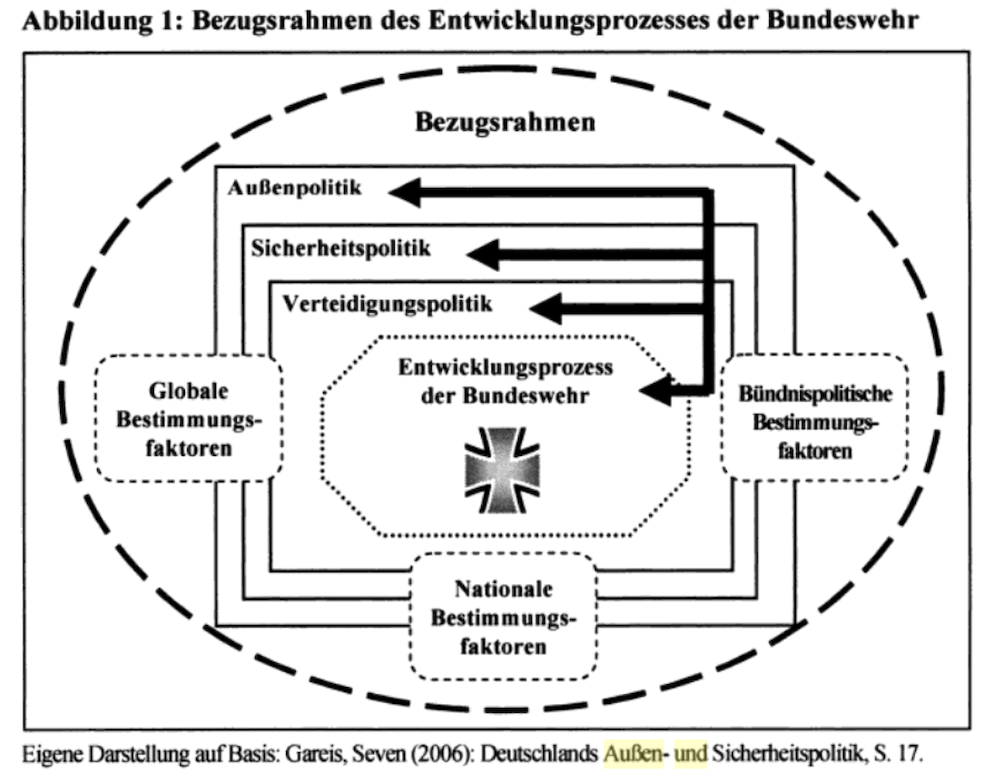Analytic Framework. The most useful framework of the German Defence Force policy process is developed by Henrick Heindekamp (2014) in his Der Entwicklungsprozess der Bundeswehr zu Beginn des 21. Jahrhunderts: Wandel im Spannungsfeld globaler, nationaler und bündnispolitischer Bestimmungsfaktoren. As the image below shows, the author views this process as nestled within the Foreign, Security, and Defence policies of the German Government, and as shaped by three key sets of factors: global, national, and coalition politics decision-making factors. This framework is closely related to the one being developed by our study.

Strategic Leadership Ethos: Germany is a perfect case study demonstrating the centrality of top executive officials’ (in particular, Federal Chancellors’) Strategic Leadership Ethos (SLE). As Fig. 1 below shows, this is structured by two axes: a Strategic Axis spanning a spectrum from Managerial to Visionary Strategy, and a Leadership Axis from a Self-Protecting type to an Empowering one. Four ‘ideal’ SLE’s emerge, which closely describe the last four German Chancellors: Helmut Schmidt as a Visionary empowering public servant, Helmut Kohl as a Visionary self-protecting opportunist, Gerhard Schroeder as a Self-protecting opportunist manager, and Angela Merkel as a Public Service Career Manager.
Dynamics: The weight and influence of a top official’s SLE fluctuates with the shifting dynamic balance of the combined effect of the independent variables (Fig. 1 below): a top executive benefitting from a large institutional autonomy, a permissive national culture, and high military capabilities will have the capacity to largely shape intervention types in accordance with his/her SLE. One functioning in an environment defined by low executive autonomy, a resistant national culture, and limited military capabilities, for example, will also see the marge de maneouvre s/he disposes to deploy his/her SLE significantly reduced. The advantage of taking this approach is that one can virtually eliminate the effect of an official’s SLE in highly resistant environments, yet allow it a wide latitude in permissive environments. This means that each country being studied will be able to not only have its own ecosystem of independent variables, but that this ecosystem can be dynamic and vary over time. By deploying a process tracing methodology for each case study, one will be able to observe not only a static view of the dependent variables, but how and why these evolved over time as a result of changes in the independent variables, in the top officials’ SLEs, and finally in the iterative learning process of that country’s institutions resulting from experience accumulation (institutional memory).
History: German foreign policy has gone, since 1949, through six main phases, each defined by the thought and action of one of its six dominant chancellors:
- Westpolitik : West-Policy: The Adenauer Era (1949-1966) – Anchoring Germany in the West (NATO membership)
- Ostpolitik : East-Policy: The Brandt Era (1966-1974) – Reconciliation with the East (Warsaw Kneefall)
- Weltpolitik : World-Policy: The Schmidt Era (1974-1982) – Germany as a Global Middle Power (NATO Doppelbeschluss)
- Europapolitik : European Policy: The Kohl Era (1982-1998) – One Germany in a United Europe (Verdun Moment)
- Personalpolitik : Personal Policy: The Schroeder Era (1998-2005) – Riding the Populist Wave ( 2003 Iraq war)
- Deutschlandpolitik : Germany-Policy: The Merkel Era (2005-2021) – Staying the Course (Euro, Migration, Crimea, Covid Crises).
Outcomes: Each of these phases represents a discrete foreign policy ecosystem characterised by its unique constellation of dependent variables (V1 to V6) and dynamic interaction between them. They are each shaped by key defining events and punctuated by more or less disruptive transitions from one to the other. So, significant changes in Germany’s foreign policy ecosystem coincided with changes in Chancellors with very different SLEs, resulting in important variations in the dependent variables defining Choice of intervention types. In terms of research this means, in my opinion that we must observe how each of the independent variables has evolved over time in the post-Cold War Era, how their cumulative dynamics have interacted with successive Chancellors’ SLE, and how these in turn have shaped the dependent variables over that period of time. One interesting observation in Germany’s case is that each of the last four Chancellors has had a relatively stable SLE that has changed only minimally over his/ her time in power. This leadership continuity is reinforced by a policy continuity emerging from the dominance of stable party coalitions in the Bundestag, where the Foreign Affairs Minister, usually the leader of the junior coalition partner, plays a key role in the the development and implementation of German foreign and defence policy during the term of each specific coalition.
